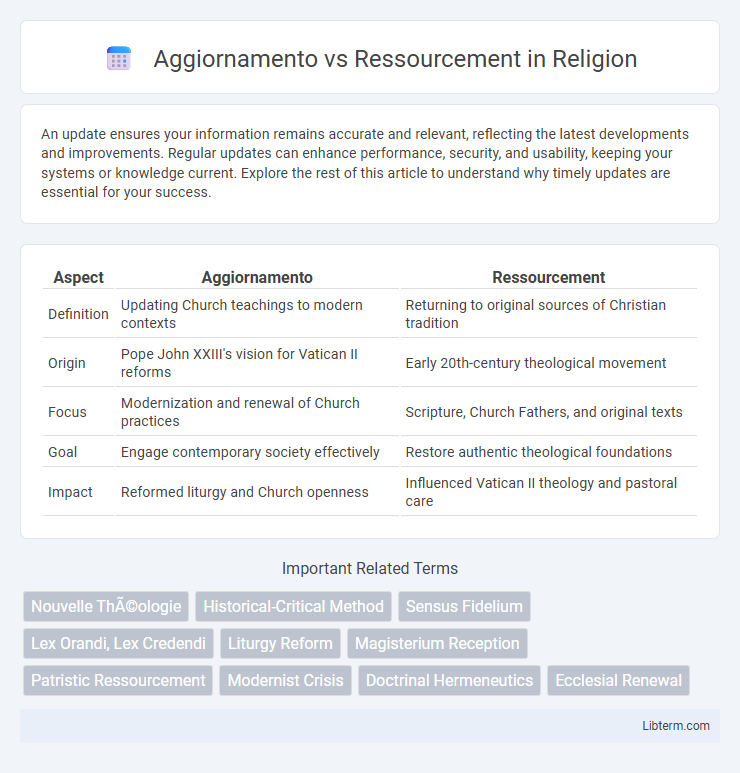An update ensures your information remains accurate and relevant, reflecting the latest developments and improvements. Regular updates can enhance performance, security, and usability, keeping your systems or knowledge current. Explore the rest of this article to understand why timely updates are essential for your success.
Table of Comparison
| Aspect | Aggiornamento | Ressourcement |
|---|---|---|
| Definition | Updating Church teachings to modern contexts | Returning to original sources of Christian tradition |
| Origin | Pope John XXIII's vision for Vatican II reforms | Early 20th-century theological movement |
| Focus | Modernization and renewal of Church practices | Scripture, Church Fathers, and original texts |
| Goal | Engage contemporary society effectively | Restore authentic theological foundations |
| Impact | Reformed liturgy and Church openness | Influenced Vatican II theology and pastoral care |
Introduction to Aggiornamento and Ressourcement
Aggiornamento refers to the process of updating and renewing the Catholic Church to address contemporary issues, emphasizing adaptation and engagement with modern society. Ressourcement signifies a return to the original sources of Christian theology, such as Scripture and Church Fathers, to revive and deepen the Church's spiritual and doctrinal foundation. Together, these movements shaped the reformative spirit of the Second Vatican Council, balancing tradition with modernization.
Historical Context: Vatican II and Theological Renewal
Aggiornamento, meaning "updating," and Ressourcement, meaning "return to the sources," were pivotal theological currents during Vatican II that shaped the Church's approach to renewal. Emerging in the mid-20th century, Ressourcement theologians like Henri de Lubac and Jean Danielou advocated returning to patristic writings to revitalize Catholic doctrine, contrasting with the modernizing impulse of Aggiornamento promoted by figures such as Pope John XXIII. Vatican II integrated both approaches, fostering a dialogue between tradition and contemporary context that redefined Church teachings and pastoral practice.
Defining Aggiornamento: Embracing Modernity
Aggiornamento refers to the process within the Catholic Church aimed at embracing modernity by updating doctrines, practices, and structures to align with contemporary societal values and scientific advancements. It emphasizes openness to change and dialogue with the modern world, promoting relevance without abandoning core theological principles. This approach contrasts with Ressourcement, which seeks renewal through a return to original sources of Christian tradition and Scripture.
Understanding Ressourcement: Returning to the Sources
Ressourcement emphasizes a theological renewal by returning directly to the original sources of Christian faith, such as Scripture and the Church Fathers, to inspire contemporary thought and practice. It contrasts with Aggiornamento, which centers on updating or modernizing Church teachings to suit current contexts. Understanding Ressourcement reveals a foundational approach aimed at deepening doctrine through historical authenticity rather than mere adaptation.
Key Figures in Aggiornamento and Ressourcement
Aggiornamento, championed by Pope John XXIII, emphasized modernizing the Catholic Church to better engage contemporary society, with key figures including theologians like Yves Congar and Joseph Ratzinger who sought renewal through aggiornamento. Ressourcement, led by thinkers such as Henri de Lubac, Jean Danielou, and Marie-Dominique Chenu, focused on returning to the sources of Christian tradition, particularly Scripture and the Church Fathers, to inspire authentic theological renewal. Both movements profoundly influenced the Second Vatican Council, blending historical fidelity with openness to modern challenges.
Methodological Differences Between the Two Approaches
Aggiornamento emphasizes adapting Church teachings to contemporary contexts through critical engagement with modern culture and new pastoral needs, whereas Ressourcement prioritizes returning to original sources like Scripture and Church Fathers to renew theology at its roots. Methodologically, Aggiornamento adopts a forward-looking, dialogical approach integrating historical tradition with present-day challenges, while Ressourcement employs a retrospective, historical-critical method aimed at reviving foundational texts for renewed theological insight. These distinct methodologies shape their unique contributions to modern Catholic theology and practice.
Impact on Catholic Doctrine and Practice
Aggiornamento emphasized modernizing Catholic doctrine and practice to engage contemporary culture, leading to reforms in liturgy and ecumenism that made the Church more accessible and relevant. Ressourcement sought to renew Catholic theology by returning to the original sources of Scripture and Church Fathers, profoundly influencing doctrinal development through a more authentic understanding of tradition. Both movements shaped Vatican II's outcomes by balancing historical fidelity with necessary adaptation, transforming Catholic worship, theology, and pastoral approaches.
Responses and Criticisms within the Church
Aggiornamento aimed to modernize the Church by updating its practices and engaging contemporary culture, generating responses that praised its openness but faced criticism for potentially diluting traditional doctrines. Ressourcement sought to return to the original sources of Christian theology, such as the Church Fathers and Scripture, prompting support for deeper theological renewal while drawing critique for perceived selective interpretation. Both movements sparked intense debate within the Church, balancing respect for tradition with the need for reform in response to modern challenges.
Contemporary Relevance and Ongoing Debates
Aggiornamento, championed during the Second Vatican Council, emphasizes updating Church practices and doctrines to engage effectively with contemporary society, fostering reform without abandoning tradition. Ressourcement advocates a return to original scriptural and patristic sources to inspire authentic renewal rooted in historic Christian wisdom, influencing theological scholarship and ecumenical dialogue. Ongoing debates center on balancing these approaches to maintain doctrinal integrity while addressing modern pastoral challenges, highlighting tensions between innovation and tradition in Catholic thought.
Conclusion: Balancing Innovation and Tradition
Aggiornamento and Ressourcement represent two complementary approaches in Catholic renewal, with Aggiornamento emphasizing modernization and openness to contemporary contexts, while Ressourcement advocates for a return to classical sources and traditions. A balanced integration of both perspectives fosters a dynamic Church that respects doctrinal roots while engaging effectively with modern challenges. This synergy ensures theological vitality, deeper spiritual renewal, and a relevant witness in an evolving cultural landscape.
Aggiornamento Infographic

 libterm.com
libterm.com